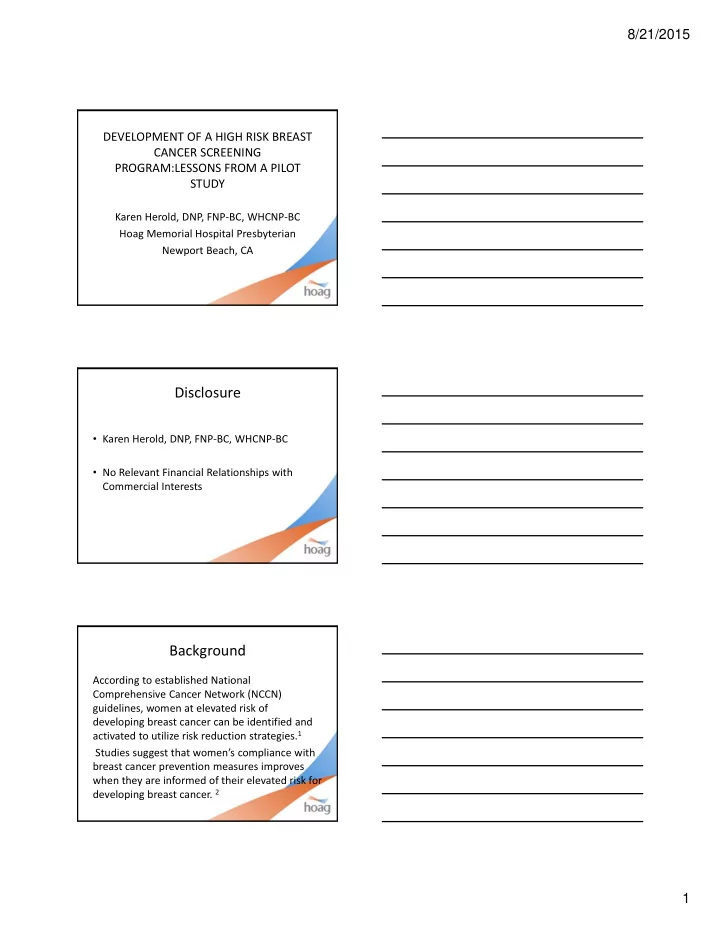

8/21/2015 DEVELOPMENT OF A HIGH RISK BREAST CANCER SCREENING PROGRAM:LESSONS FROM A PILOT STUDY Karen Herold, DNP, FNP ‐ BC, WHCNP ‐ BC Hoag Memorial Hospital Presbyterian Newport Beach, CA Disclosure • Karen Herold, DNP, FNP ‐ BC, WHCNP ‐ BC • No Relevant Financial Relationships with Commercial Interests Background According to established National Comprehensive Cancer Network (NCCN) guidelines, women at elevated risk of developing breast cancer can be identified and activated to utilize risk reduction strategies. 1 Studies suggest that women’s compliance with breast cancer prevention measures improves when they are informed of their elevated risk for developing breast cancer. 2 1
8/21/2015 Design: retrospective descriptive analysis Sample: females between the ages of 35-55, self-enrolled, no history of breast cancer Procedure: online empiric risk assessment, individualized counseling session utilizing risk-specific recommendations based on NCCN guidelines. 3 Ninety days after enrolling in the program, participant's were invited to complete a 90 day post program survey to assess the effectiveness of the program and to measure individual uptake of NCCN recommendations Measures: the Gail Risk Assessment tool 4 Findings • 140 completed a 90-day post program survey, their mean age was 45.2 years (SD=6.3), 54% were highly educated (bachelor’s degree and higher) with a median annual income of $100,000. • Of those initially enrolled (N=297), 14% were identified at elevated risk (Gail five-year risk >1.67) compared to 11.4% of the 140 who completed a 90-day post program survey. • 94% of those at elevated risk opted to receive clinician counseling, compared to 46% of those who were at average risk. • Using a two-sample test for equality of proportions, those who received both written and clinician counseling were more likely to adopt NCCN lifestyle recommendations (Prop= 0.123 ) to reduce their risk of breast cancer than those who received written information only (Prop=0.067) Discussion • The percentage of women identified at elevated risk for developing breast cancer was close to that identified nationally • Most opted to take further steps (clinician counseling) to mitigate their risk. • Skewed sample in terms of socioeconomic status (SES); further research to understand the uptake of clinician counseling and NCCN lifestyle recommendations among women with SES profiles typical of the national average. 2
8/21/2015 References 1. National Cancer Institute (NCI). In NCI Breast Cancer Risk in American Women. Retrieved September 1, 2014 from http://www.cancer.gov/cancertopics/factsheet/detection/probability- breast-cancer 2. Tracy, K., Quillin, J., Wilson, D., Borzelleca, J., Jones, R., McClish, D., Bowen, D., & Bodurtha, J. (2008). The impact of family history of breast cancer and cancer death on women's mammography practices and beliefs. Genetics in Medicine (2008) 10, 621–625. 3. National Comprehensive Cancer Network (NCCN). In NCCN Clinical Practice Guidelines in Oncology: Breast cancer screening and diagnosis Version 1.2013. Retrieved August 13, 2014 from http://www.nccn.org/professionals/physician_gls/PDF/breast_risk.pdf 4. National Cancer Institute (NCI). In NCI Breast Cancer Risk Assessment Tool. Retrieved August 13, 2014 from http://www.cancer.gov/bcrisktool/about-tool.aspx 3
Recommend
More recommend